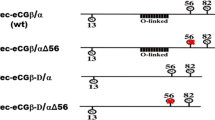Abstract
125I-human chorionic gonadotropin (125I-hCG) bound to plasma membranes of bovine corpora lutea consisted of reversible and not readily reversible fractions. The not readily reversible fraction progressively increased as the length and the temperature of preincubation were increased. The not readily reversible fraction was, however, completely eluted after any time or temperature of preincubation. Although the not readily reversible and reversible bound 125I-hCG were precipitated equally well with 10% trichloroacetic acid, the not readily reversible bound 125I-hCG was able to rebind much higher to fresh plasma membranes compared to reversible bound 125I-hCG. These findings suggest that while not readily reversible bound 125I-hCG was intact, the reversible bound 125I-hCG was somewhat altered during the binding reaction.
Similar content being viewed by others
References
Reichert L.E. Jr., Leidenberger F., Trowbridge G.G. Studies on luteinzing hormone and its subunits: development and application of a radioligand receptor assay and properties of the hormone-receptor interaction. Recent Prog. Horm. Res. 29: 497, 1973.
Rao Ch. V. Mechanism of nucleotide inhibition of gonadotropin binding to cell membranes of bovine corpus luteum. Mol. Cell. Endocrinol. 3: 255, 1975.
Chen C. J.H., Lindeman J.G., Trowbridge C.G., Bhalla V.K. Gonadal receptors. I. Evidence for irreversibility in the binding of human chorionic gonadotropin and human luteinizing hormone. Biochim. Biophys. Acta 584: 407, 1979.
Katikineni M., Davies T.F., Huhtaniemi I.T., Catt K.J. Luteinizing hormone — receptor interaction in the testis: progressive decrease in reversibility of the hormone receptor complex. Endocrinology 107: 1980, 1980.
Rao Ch.V. Properties of gonadotropin receptors in the cell membranes of bovine corpus luteum. J. Biol. Chem. 249: 2864, 1974.
Lowry O.H., Rosebrough N.J., Farr A.L., Randall R.J. Protein measurement with folin phenol reagent. J. Biol. Chem. 193: 265, 1951.
Miyachi Y., Vaitukaitis J.L., Neischlag E., Lipsett M.B. Enzymatic radioiodination of gonadotropin. J. Clin. Endocrinol. Metab. 34: 23, 1972.
Rao Ch.V., Griffin L.P., Carman F.R., Jr. Gonadotropin receptors in human corpora lutea of the menstrual cycle and pregnancy. Am. J. Obstet. Gynecol. 128: 146, 1977.
Steel R.G., Torrie J.H. Principles and procedures of statistics. McGraw-Hill, New York, 1960.
Andersen T.T., Curatolb L.M., Reichert L.E., Jr. Follitropin binding to receptors in testis: studies on the reversibility and thermodynamics of the reaction. Mol. Cell. Endocrinol. 33: 37, 1983.
van der Gugten A.A., Waters M.J., Murthy G.S., Friesen H.G. Studies on the irreversible nature of prolactin binding to receptors. Endocrinology 106: 402, 1980.
Powell-Jones C.H.J., Saltiel A.R., Thomas C.G. Jr., Nayfeh S.N. Dissociation kinetics of the thyrotropin-receptor complex. Characterization of a slowly dissociable component. Mol. Cell. Endocrinol. 24: 219, 1981.
Saltiel A.R., Thomas C.G. Jr., Nayfeh S.N. Thyrotropin binding to porcine thyroid plasma membranes: kinetics and thermodynamic analyses. Mol. Cell. Endocrinol. 28: 299, 1982.
Donner D.B., Casadei J., Hortstein L., Martin D., Sonenberg M. Characterization of the slowly dissociable human growth hormone binding component in isolated rat hepatocytes. Biochemistry 19: 3293, 1980.
Clark S., Harrison L.C. Insulin binding leads to the formation of covalent (-S-S-) hormone receptor complexes. J. Biol. Chem. 257: 12239, 1982.
Rao Ch.V., Carman F.R. Jr., Chegini N., Schultz G.S. Binding sites for epidermal growth factor in human fetal membranes. J. Clin. Endocrinol. Metab. 58: 1034, 1984.
Rao Ch.V., Ramani N., Chegini N., Stadig B., Carman F.R. Jr., Woost P., Schultz G.S., Cook C.L. Topography of human placental receptors for epidermal growth factor. J. Biol. Chem. 260: 1705, 1985.
Ramani N., Chegini N., Rao Ch. V., Woost P.G., Schultz G.S. The presence of epidermal growth factor binding sites in the intracellular organelles of term human placenta. J. Cell Sci. 84: 19, 1986.
Author information
Authors and Affiliations
Rights and permissions
About this article
Cite this article
Rao, C.V., Carman, F.R. The nature of reversible and not readily reversible bovine corpus luteum plasma membranes bound human chorionic gonadotropin. J Endocrinol Invest 9, 403–406 (1986). https://doi.org/10.1007/BF03346951
Received:
Accepted:
Published:
Issue Date:
DOI: https://doi.org/10.1007/BF03346951




